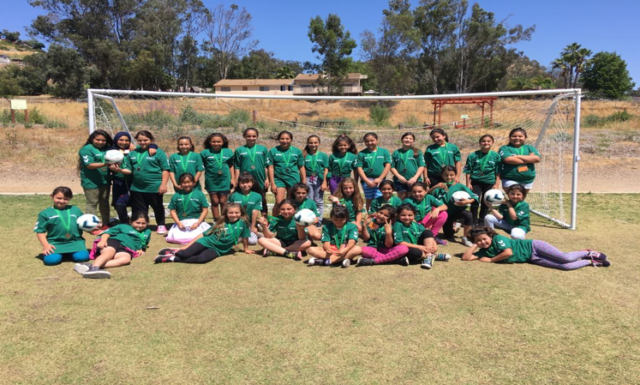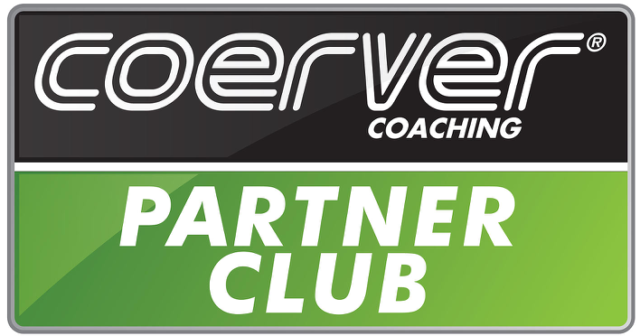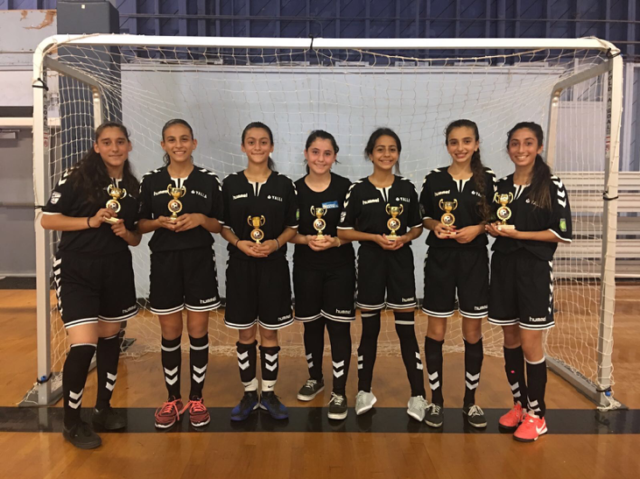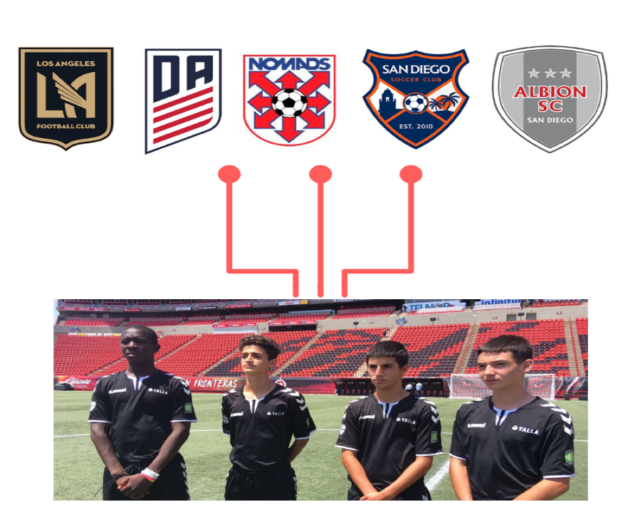Coerver San Diego has had the privilege of partnering with many youth clubs throughout San Diego for the past few years. In the past, Coerver San Dieg
Coerver San Diego has had the privilege of partnering with many youth clubs throughout San Diego for the past few years. In the past, Coerver San Diego has partnered with LA Galaxy San Diego, Rebels Soccer Club and Liverpool SC. Currently, we are partnered with Blast SC, Encinitas Express and Real Henderson FC (Nevada). For the past three years, and until recently, Coerver San Diego was partnered with a small and unique club in El Cajon, Yalla San Diego.
Yalla started seven years ago with a mission to remove the social and economic barriers that confront refugee and immigrant youth in El Cajon. Yalla combines the promise of education and the passion of football to inspire refugee and immigrant youth to achieve a college education. Yalla programs are provided at no cost to the student-athletes.
When we partnered with Yalla three years ago, Yalla was already becoming an academic powerhouse (Yalla has helped its students secure $5 million in college scholarships, including two Gates-Millennium scholars). Yalla partnered with Coerver San Diego to develop the football program into a powerhouse of player development. Our vision was a program guided solely by the simple premise of doing what’s best for the scholar-athlete over the long-term, and discarding everything else. We wanted to give the football-loving neighborhood kids an opportunity to develop into top players, students, and citizens. We wanted to build a true identity. We wanted to create a club, not merely maintain a loose affiliation among independent teams and call it a club. Being able to have kits and use a Custom Football. This would only increase the teams morale. I give much gratitude and credit to Yalla’s founder and former Executive Director, Mark Kabban, and Yalla’s subsequent Executive Director Sarah Cooper, for allowing us to execute this vision.
Here’s what we accomplished:
Playing Style
During our partnership Yalla improved across all standard football metrics. For example, the game results of the competitive teams improved dramatically on average, and while maintaining the same competitive level: more wins, more goals scored, fewer goals conceded, no forfeited games, and fewer yellow and red cards. Most importantly, however, a true club identity emerged through our playing style. Our improved results in games were the byproduct of the development of our playing style. See the link below to watch a short highlight of our 06/07 boys in action
Coerver San Diego Game Model 9v9 – Attacking from Coerver San Diego on Vimeo.
Training Environment and Game Model
We overhauled Yalla’s programs, structure, and standards. For example, we implemented a club-wide lexicon, including game calls, to streamline communication and identify our key learning concepts with specific terms, including the USSF positional numbering system. We designed and implemented a specific club-wide game model, and based on those principles, set forth a specific curriculum, including training and gaming based on the principles of periodization.
We introduce progressively demanding standards over the three years. All teams trained in the same way, at the same location, on the same days, and used the same lexicon. All players trained in white socks, black shorts, Yalla training top, shin guards, and cleats – no exceptions. Players arrived on time or communicated with the coaching staff ahead of time – no exceptions. When players arrived at training they shook hands with the entire staff and began the warm-up rondo – no exceptions. All competitive players attended Yalla’s academic program – no exceptions.
All of our training sessions were based on the reference of the football action theory –and thus every activity involved communication, decision, and execution. In other words, players always trained in context and were able to attack, transition, and defend. All of our sessions were focused on either individual decision-making or communication and team tactics within our playing style. All conditioning/fitness training was football conditioning – playing football to increase our tempo or maintain our playing style for longer. We pushed all isolated ‘technical’ work to the players’ free time and supported the players with video libraries of ‘technical’ work and tests. Occasionally, we tested the players before practice: they had 5 minutes to accomplish the prescribed score for their age/level. If they passed, they joined training. If they did not pass, they re-tested until they passed. This was not punitive. We created a culture of personal accountability. Many players set their own standards that far exceeded the standards of the club.
Head Coaches, Tournaments, and Player Pathway
We broke with standard club practice in three ways. First, we eliminated the title of head coach and assistant coach, and instead tasked all coaches as “staff coaches”. This enabled us to mitigate coach ego regarding wins and losses, develop better coaches by pairing newer coaches with seasoned coaches, and develop better players by having our best coaches train more players while simultaneously giving every player the benefit of our entire staff. Second, we cut down the number of summer tournaments and instead focused more on scrimmages; that gave us the flexibility to structure the games to match our developmental needs (i.e., play, train, play) and also lowered our costs. Third, we introduced a player pathway based on level and commitment, and tiered “competitive players/competitive teams” and “development players/development player pool.” New players began the pathway not through tryouts, but rather by demonstrating their commitment and level by attending “Street Soccer Sunday” (see below). The next step on the pathway was a formal invitation to our development player pool, a parent meeting, and an invitation to our academic programs. Development players trained twice a week and vied to earn a coveted spot on a competitive team. Competitive players trained three to four times per week and played in league games. Top competitive players with outstanding academics were taken on trial with professional academies and US Development Academy teams.
Unique Programming
One of my favorite programs we launched with Yalla is “Street Soccer Sunday”. Every single Sunday for the past three years, Yalla players and community members gathered to play two hours of pick-up style futsal across 6 outdoor basketball courts. The 5-minute games are short and fiercely competitive. If you score in the first 2 minutes, you win. Otherwise, first team to score 2 goals wins. Loser is sent off the field, winner stays. There’s even promotion and relegation between the courts. The courts are initially separated by age (loosely), but if you’re good enough, you’re old enough, and young players have often, albeit briefly, found themselves on the top court (Champions League). The players took ownership of this program. They bring the balls and goals, they setup, they organize teams, they set the rules, they mediate disputes. I would just go to watch them play, catch-up with the players watching (in sports-based youth development lingo: “informal time”), and jump in and play too.

Another fantastic program we implemented was the “Anza Girls’ Program”. We ran this girls-only after school football program with a local elementary school with 70% refugee enrollment. For several semesters we worked with about 40 girls, many of whom this was their very first footballing experience. Nevertheless we maintained a high-standard of player development, and were able to get them excited and engaged with football. The crowning achievement was developing their ability to pass and receive in rondos – the girls’ record after only six sessions was 23 consecutive passes in a 5v1 rondo in a 10×10 yard area. That’s a staggering achievement at any level. Moreover, the girls’ program and other similar after school programs we ran at local middle and high schools gave us an opportunity to work with refugee students who often had just arrived in the US weeks or even days before joining our program. There is no way to quantify the value of welcoming a newcomer to your country and helping them engage with their peers through football.
Top Players, Top Students
On the competitive side, our female players have dominated the Soccer Kids America futsal circuit for the past two years. They have won the league 5+ times even playing up in the high school division. The girls bought into the game model and executed it so well that parents, players, and coaches from other teams would go out of their way just to watch our girls play. The girls took full ownership of the process, running warm-ups, half-time talks, and in-game coaching. They’re also academic all-stars, and two of the seven were voted “El Cajon Youth of the Year” by their schoolteachers.
I am incredibly proud of our ability to move players to higher levels while staying true to Yalla’s academic principles. For example, we took four of our Boys’ 2001 players to trials with Development Academy teams because they had the playing level and each had a GPA above 3.5. The four were signed to the DA. Three of the four now boast 4.0+ GPAs. I also had the privilege of taking a 2004 player who was scouted by LAFC to trial with LAFC’s 2004 academy, which is one of the top 2004 teams in the country with several USYNT players. Although the trek to LA is a bit too far to continue with LAFC at this point, he’s now in a good place with a quality coach and good players at San Diego Soccer Club. We were also able to place one of our female players with a South Bay Matrix team who she helped to win Cal South President’s Cup.
Of course every club has its claims to players it’s produced but what is pure about Yalla is that we simply took the neighborhood kids, the kids who showed up, kids who have never played organized football outside of Yalla, and developed each of them as footballers, students, and citizens.
Although I am disappointed that our project with Yalla is over, I’m proud that we were successful in achieving our goals. We gave the football-loving, neighborhood kids an opportunity to develop into top players, students, and citizens. We promoted players to the highest-level of youth football in San Diego. We created a club with a true identity, and our players were proud of that identity.
Now it is time to move onto the next project. We’re excited to find new partners who share our vision that a club should be more than a loose affiliation of teams. We’re excited to work with clubs, coaches, players, and parents who want to raise their standards and challenge the status quo of player and team development. It’s amazing what’s possible when people are willing to do what’s right.
On a final note, I have not used “we” casually in this article. “We” refers to the entire Yalla family, to the staff, coaches, parents, and supporters. “We” also refers to Coerver staff, including myself and Duda Coelho. “We” most importantly refers to the players. The players are Yalla Football Club. Not one of the accomplishments I’ve mentioned in this article would have been possible without their commitment, their effort, their trust, their desire, their talent, or their input. Here is a great video by ESPN on our Yalla Family.



